Identification
Common elderberry or American elder (Sambucus nigra L. ssp. canadensis or just Sambucus canadensis) is a shrub that's commonly found throughout most of North America. Its characteristic cream-colored flowers, or elderflowers, are often seen on the road-side in late spring and early summer.
The flowers grow in umbels, which are sort of umbrella-shaped clusters. The umbels are normally six inches or so in diameter.
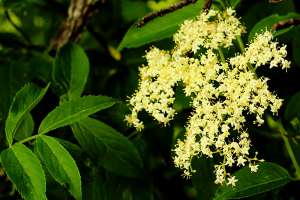
Elderflower umbel and leaves
Once the elderflowers, also called elderblow, are finished, they yield to clusters of small dark purple berries that ripen mid-summer to early fall.
Elderberry trees have opposite, elongated, toothed leaflets that are three to four inches long.
Leaves, stems, bark and roots are toxic, so it's important to be vigilant about not including any of these when processing elderberries or elderflowers. The berries, bark and leaves have been used traditionally in medicinal preparations.
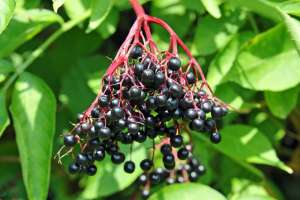
Watch out for Hercules' club which has similar leaves and berries -- the berries are poisonous. Hercules' club's berry clusters are flat instead of round, and the stems are covered in thorns, while elderberry stems are smooth.
Edibility
Can you eat raw elderberries?
Cooked ripe elderberries are perfectly edible. Unripe elderberries are poisonous. Raw berries can cause nausea, vomiting, and diarrhea, among other symptoms, so be sure to cook them before eating. Cooking the berries also improves their flavor.
Elderberries can be baked into pastries, cooked into a syrup or dried for later use.
See our elderberry syrup recipe.
The only edible parts of the elderberry tree are the berries and flowers.
Here's a great video about the virtues of Elder by Rosemary Gladstar, one our favorite herbalists.
How to harvest
Harvesting elderflowers
Harvest the flowers when they appear or leave them on the tree and come back for elderberries later. Less-traveled country roads are good places to forage for elderflowers and elderberries but stay away from busy roads (more about that in our foraging guidelines).
To harvest elderflowers, cut off flower heads with scissors, keeping in mind that flowers develop into berries and harvesting them will detract from berry production.
As a side note, call us superstitious, but we always ask permission before harvesting elderflower or berries. Actually, we do that for everything but this is an old tradition with the Elder tree.
Harvesting elderberries
What's tricky is getting to the berries before the birds get them, because they really start to disappear once they're ripe.
The best way to make sure you get to them before they're gone is to drape mesh or netting over the flowers. Be sure to leave space between the netting and the flowers to prevent berry damage from penetrating birds' beaks.
I always try to leave plenty for the wildlife that depends on elderries for food, taking only what I will reasonably use.
The process of harvesting the berries is basically the same as harvesting the flowers. Simply cut off the stems with scissors and put in a paper bag.
If you feel like doing something monotonous and meditative, then painstakingly pick every berry from its stem.
But if you'd like to get on with your day, put your paper bag full of elderberries in the freezer for an hour or so until the berries are completely frozen.
Then, making sure the bag is closed, shake it up a bit to help loosen the berries. For the berries that still aren't loose, just rub them away from the stems with your hands.
You can then put the berries into a bucket of water to help separate any debris that may be mixed in. Then pour off the water.
You can use the berries right away, freeze them, or dry them to use later.
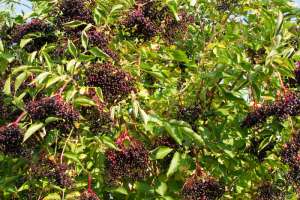
How to dry flowers
Elderflowers can be used fresh or dried for later use. To dry, either lay the fresh flower heads on a piece of cardboard or hange them in a well-ventilated shady, dry area.
They're ready for storage when they can be easily brushed off of the stems. Store in air-tight glass jars or something similar.
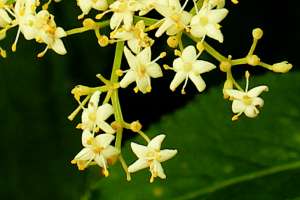
Habitat
The Common elderberry grows throughout most of the United States.
It's a really versatile tree that thrives in a variety of conditions, but it loves areas with lots of moisture and nitrogen. Look for it along streambanks, in damp woods, open fields, old homestead sites, and power line cuts.
While the elderflowers are blooming in late spring/early summer, it's easy to spot them growing in thickets along the road.
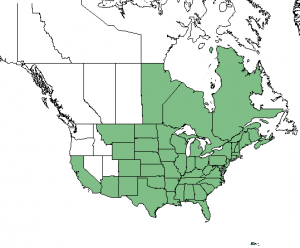
Recipes and uses
Elderberry Syrup
I just discovered this awesome video about making elderberry syrup with Sylvie Doré of Redwood Fairy Herbs & Ferments.
You can also check our our own elderberry syrup recipe (complete with echinacea and turkey tail mushrooms).
Elderflower Cordial
Elderflower cordial is a drink that dates back as far as the Roman Empire -- an ancient soft drink.
Traditionally, it's mixed with carbonated water before drinking, but this recipe makes a naturally bubbly sparkler -- no carbonated water needed.
We love making a big batch so that we can preserve and enjoy summer into the colder months.
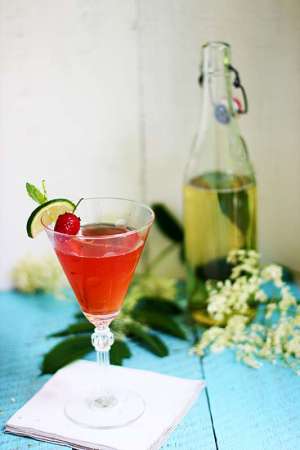
Ingredients:
-
3 1/2 cups caster sugar
-
2 cups hot water
-
4 large fresh elderflower heads
-
2 TBL white wine vinegar
-
juice or rind of 1 lemon
-
7 pints water
-
Fresh strawberry juice (optional)
Instructions:
-
Mix sugar and hot water.
-
Pour mixture into large glass container.
-
Add remaining ingredients and stir well.
-
Cover and let sit at room temperature for 5 days.
-
Strain liquid into sterilized screw- or flip-top bottles and let sit another week.
Notes:
Serve cold and garnish with lemon, strawberry, and/or mint. Add fresh strawberry juice for flavor and color.
Elderflower Tea
Elderflower is naturally sweet and makes an excellent floral tea that really doesn't need any added sweetener.
To make tea from fresh elderflowers, boil a pot of water and add two to four freshly cut elderflower heads to steep for 10 minutes.
If you're using dried elderflower, steep two teaspoons in a cup of boiled water for ten minutes.
Comments
Interesting that you don't include Washington state as part of the range for elderberries. I've been harvesting them for years, as did my mother before me. East of the Cascades they are abundant. They're the whitish ones, not the dark blue.
I'm guessing you harvested Blue elderberry (Sambucus nigra ssp. caerulea), which could be whitish in some cases? Not sure as we don't have them here. The range map is for Common elderberry (Sambucus nigra ssp. canadensis).